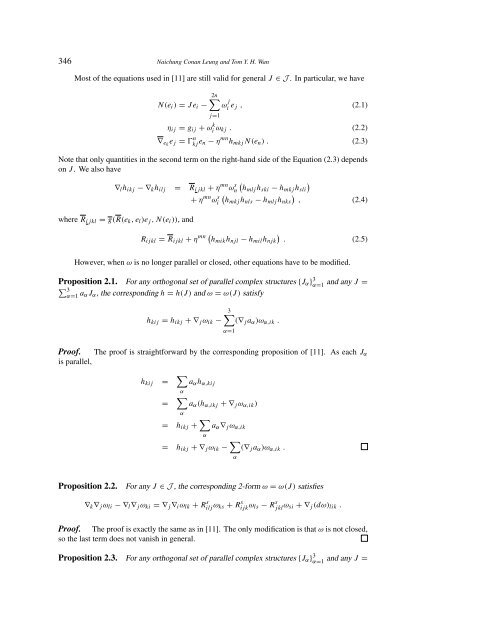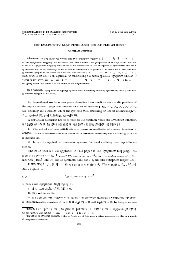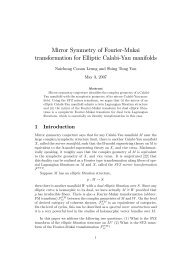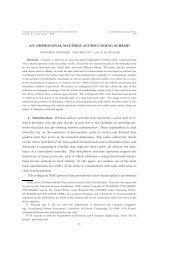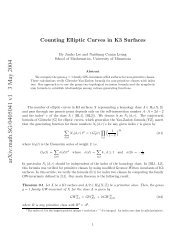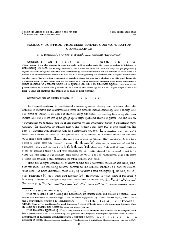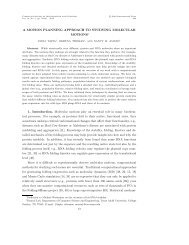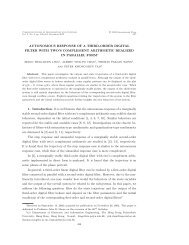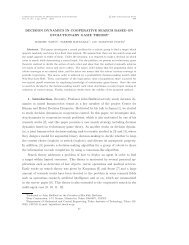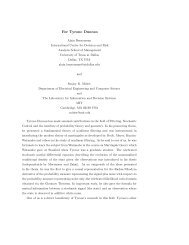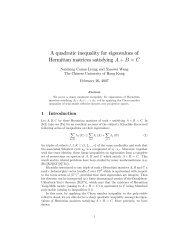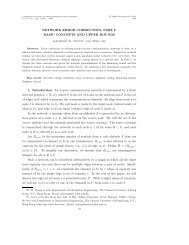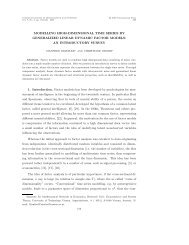Hyper-Lagrangian Submanifolds of Hyperkähler Manifolds and ...
Hyper-Lagrangian Submanifolds of Hyperkähler Manifolds and ...
Hyper-Lagrangian Submanifolds of Hyperkähler Manifolds and ...
You also want an ePaper? Increase the reach of your titles
YUMPU automatically turns print PDFs into web optimized ePapers that Google loves.
346 Naichung Conan Leung <strong>and</strong> Tom Y. H. Wan<br />
Most <strong>of</strong> the equations used in [11] are still valid for general J ∈ J . In particular, we have<br />
N(e i ) = Je i −<br />
2n∑<br />
j=1<br />
ω j i e j , (2.1)<br />
η ij = g ij + ω k i ω kj . (2.2)<br />
∇ ek e j = Ɣ n kj e n − η mn h mkj N(e n ). (2.3)<br />
Note that only quantities in the second term on the right-h<strong>and</strong> side <strong>of</strong> the Equation (2.3) depends<br />
on J . We also have<br />
∇ l h ikj −∇ k h ilj = R ijkl + η mn ωn<br />
s ( )<br />
hmlj h ski − h mkj h sli<br />
+ η mn ωi<br />
s ( )<br />
hmkj h nls − h mlj h nks , (2.4)<br />
where R ijkl = g(R(e k ,e l )e j ,N(e i )), <strong>and</strong><br />
R ij kl = R ij kl + η mn ( h mik h nj l − h mil h nj k<br />
)<br />
. (2.5)<br />
However, when ω is no longer parallel or closed, other equations have to be modified.<br />
Proposition 2.1. For any orthogonal set <strong>of</strong> parallel complex structures {J α } 3 α=1<br />
<strong>and</strong> any J =<br />
∑ 3α=1<br />
a α J α , the corresponding h = h(J ) <strong>and</strong> ω = ω(J) satisfy<br />
3∑<br />
h kij = h ikj +∇ j ω ik − (∇ j a α )ω α,ik .<br />
Pro<strong>of</strong>. The pro<strong>of</strong> is straightforward by the corresponding proposition <strong>of</strong> [11]. As each J α<br />
is parallel,<br />
α=1<br />
h kij = ∑ α<br />
= ∑ α<br />
a α h α,kij<br />
a α (h α,ikj +∇ j ω α,ik )<br />
= h ikj + ∑ α<br />
a α ∇ j ω α,ik<br />
= h ikj +∇ j ω ik − ∑ α<br />
(∇ j a α )ω α,ik .<br />
Proposition 2.2.<br />
For any J ∈ J , the corresponding 2-form ω = ω(J) satisfies<br />
∇ k ∇ j ω li −∇ l ∇ j ω ki =∇ j ∇ i ω lk + R s ilj ω ks + R s ij k ω ls − R s jkl ω si +∇ j (dω) lik .<br />
Pro<strong>of</strong>. The pro<strong>of</strong> is exactly the same as in [11]. The only modification is that ω is not closed,<br />
so the last term does not vanish in general.<br />
Proposition 2.3. For any orthogonal set <strong>of</strong> parallel complex structures {J α } 3 α=1<br />
<strong>and</strong> any J =


